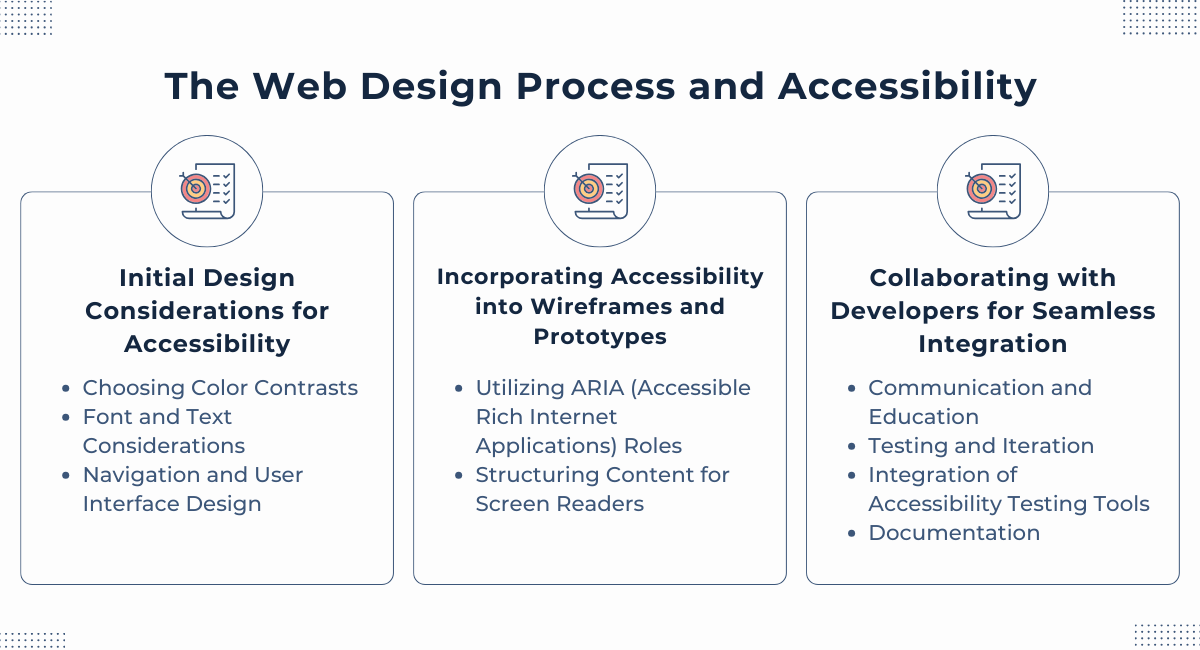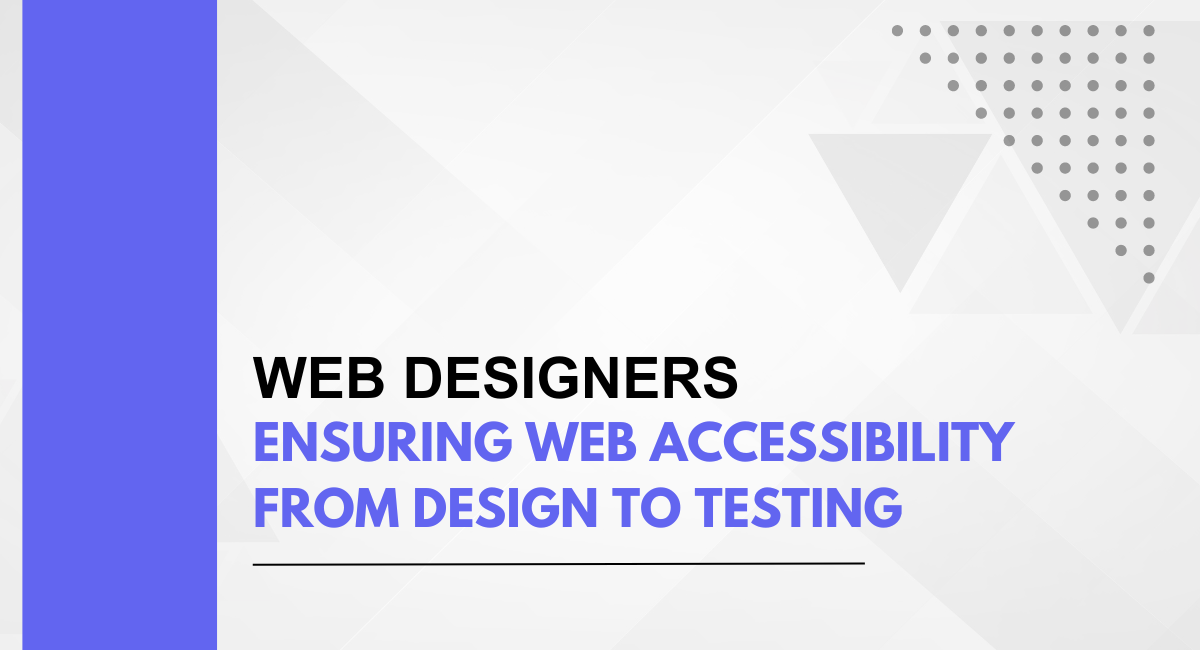Web accessibility has become a crucial aspect of designing and developing websites. Web accessibility refers to ensuring that websites and web applications are usable by people of all abilities, including those with disabilities. This inclusivity extends to individuals with visual, auditory, motor, or cognitive impairments.
The importance of web accessibility lies in its ability to provide equal access and a positive user experience for everyone, fostering inclusivity and diversity on the internet. Web designers play a pivotal role in creating an accessible online environment. They are responsible for making design decisions that consider the diverse needs of users, ensuring that websites are navigable, perceivable, and operable for individuals with varying abilities.
Key considerations include:
- Providing alternative text for images.
- Designing intuitive navigation structures.
- Using contrasting colours for readability.
- Implementing keyboard-friendly interfaces.
By incorporating web accessibility best practices, web designers contribute to a more inclusive web where all information and services are available.
The projected Web Design Market size is expected to attain a multimillion USD valuation by 2029, experiencing an unforeseen Compound Annual Growth Rate (CAGR) from 2022 to 2029 compared to 2022.
The Web Design Process and Accessibility

A. Initial Design Considerations for Accessibility
Choosing Color Contrasts:
- Consider the contrast between text and background colours to ensure readability for users with visual impairments.
- Adhere to WCAG (Web Content Accessibility Guidelines) standards for colour contrast ratios, especially for essential content.
Font and Text Considerations:
- Opt for readable fonts with clear distinctions between characters.
- Provide options for users to adjust font sizes without compromising the layout.
- Ensure there is sufficient spacing between lines and paragraphs for improved legibility.
Navigation and User Interface Design:
- Design an intuitive and consistent navigation structure that is easy to understand and use.
- Implement keyboard navigation to accommodate users who rely on assistive technologies.
- Use clear and descriptive labels for links and buttons to enhance navigation for screen reader users.
B. Incorporating Accessibility into Wireframes and Prototypes
Utilizing ARIA (Accessible Rich Internet Applications) Roles:
- Integrate ARIA roles to enhance the accessibility of dynamic content and interactive elements.
- Use roles such as "button," "navigation," and "alert" to provide additional information to assistive technologies.
Structuring Content for Screen Readers:
- Ensure proper semantic HTML markup to convey the document structure accurately.
- Use headings, lists, and landmarks to create a well-organized content hierarchy for screen reader users.
- Provide alternative text for images, form elements, and other non-text content.
C. Collaborating with Developers for Seamless Integration
Communication and Education:
- Foster open communication between designers and developers to ensure a shared understanding of accessibility requirements.
- Provide educational resources and training on accessible design principles for the entire team.
Testing and Iteration:
- Collaborate on testing efforts to identify and address accessibility issues during development.
- Iterate designs based on feedback from users with disabilities and testing results.
Integration of Accessibility Testing Tools:
- Explore and recommend accessibility testing tools to integrate into the development workflow.
- Automate accessibility checks where possible to catch issues early in the development process.
Documentation:
- Document accessibility considerations and guidelines within project documentation for future reference.
- Create a shared repository of web accessibility best practices and resources for the design and development team.
By incorporating accessibility considerations into the early stages of the web design process and maintaining a collaborative approach with developers, designers can ensure that accessibility is seamlessly integrated into the final product. This commitment to inclusivity aligns with ethical design practices and enhances the user experience for individuals with diverse abilities.
Common Accessibility Testing Challenges and Solutions

Addressing Issues Related to Color and Contrast
Users with visual impairments often encounter challenges when colour contrast is insufficient, hindering their ability to perceive content effectively. To address this, designers should adhere to WCAG guidelines, ensuring that text and interactive elements maintain proper contrast ratios.
Additionally, utilizing online contrast-checking accessibility testing tools can help verify and adjust colour combinations. To enhance comprehension, designers should avoid relying solely on colour to convey information and incorporate alternative indicators such as icons or patterns. Providing text labels or tooltips for colour-coded elements provides a more accessible experience.
Ensuring Keyboard Navigation Is Smooth and Intuitive
Smooth and intuitive keyboard navigation is essential for users who rely on keyboards or alternative input devices. Designing a logical tab order ensures users can navigate through interactive elements in a meaningful sequence. Skipping navigation links or controls repeated on multiple pages is crucial to streamline the user experience.
To make keyboard focus clear and visible, designers can use CSS styles or focus indicators to highlight the focused element. Testing the entire user flow using only the keyboard helps identify and address any navigation challenges that users may face.
Providing Alternative Text for Images and Multimedia Content
Users with visual impairments heavily rely on alternative text to understand the content and context of images. To address this, designers should provide descriptive and concise alternative text for images, clearly conveying their purpose and context. It is crucial to use empty alt attributes (alt="") for decorative images that do not get meaningful content.
Generic terms like "image" or "image of" should be avoided, and designers must aim to offer more specific descriptions. By ensuring meaningful alternative text, designers contribute significantly to making images and multimedia content accessible to a broader audience.
Making Forms and Interactive Elements Accessible
Forms and interactive elements pose challenges for users with mobility or cognitive impairments, necessitating thoughtful design considerations. Clear labeling of form fields and additional instructions is crucial for user understanding. Using HTML label elements and associating them correctly with form controls enhances usability.
Descriptive error messages should be provided when form submissions fail, highlighting specific field(s) with errors and suggesting corrections. Custom interactive elements, such as sliders or date pickers, must be designed to be accessible and operable via keyboard input. Testing these elements with assistive technologies ensures usability and contributes to a more inclusive user experience.
Ensure Web Accessibility
Web designers are urged to prioritize web accessibility in their work. By embracing accessible design principles from the initial stages of a project, designers can create websites and applications that cater to a broader user base. This involves considering the diverse needs of users, adopting web accessibility best practices, and staying informed about evolving accessibility standards.
By championing accessibility, web designers contribute to a more equitable online experience for individuals with disabilities, reinforcing that the web is a space for everyone.
The journey toward web accessibility is ongoing and requires a collective commitment from the design and development community. By staying attuned to the principles discussed and fostering a culture of web accessibility, designers can play a pivotal role in shaping a digital landscape that is truly inclusive and accessible to all.
You may also be interested in Web Application Testing in 2024: Tools & Best Practices.
Book a Demo and experience ContextQA testing tool in action with a complimentary, no-obligation session tailored to your business needs.
We make it easy to start with the ContextQA tool: Start Free Trial.
